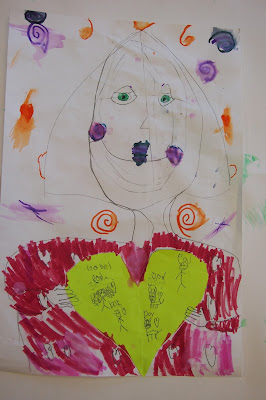 |
| Second grade artist |
During two Mind Move Make classes we became intimate with Taro Gomi's lovely book
Over the Ocean. Japanese author and illustrator Taro Gomi is best known for her hilarious book
Everybody Poops. All of her books share charm and whimsey.
Over the Ocean tells the story of a little girl standing on a beach and wondering what exists on the other side of the ocean. She is young enough to invent all sorts of interesting, imaginary scenarios about what might be across a vast expanse of water.
In starting the class I asked the students if they had ever visited the ocean. Everyone raised their hands. I asked if they ever imagined what was on the other side? We shared a few ideas before I began reading the book.
One thing I adore about teaching children is that they always notice things that I might not. After reading the book, a couple of my students recognized that the same boat is in every single picture frame throughout the book. Together we looked through the book a second time and observed that one small boat travels from one side of the book to the other throughout the course of the story. The only page it does not exist is the last one, and we are left to believe that it still travels on beyond the scope of our vision. What a beautiful detail and how wonderful that my students saw it. This reminds me that there are many ways of paying attention in the world.
After exploring this discovery, the children went on an imaginary trip to the ocean. They had the opportunity to become comfortable, close their eyes, and tap into their senses to recreate the ocean in their minds' eye. We went through all of the senses and they imagined what they would hear, see, smell, taste, and feel in a place where water meets sky. Then I asked them to visualize what could be on the other side of the water. All students had the opportunity to share what they saw as we went around the circle and shared our experiences. Standing in a circle, each student became something her or she saw, heard, felt, or tasted during the imaginary experience. The room filled with seagulls, seashells, ocean waves, and sunshine as the children transformed themselves.
Then the students got to travel to the ocean through movement. They started by becoming the ocean waves in a seated position, rolling forwards and backwards through the spine. In child's pose we became seashells, arms and legs waving we became jellyfish. Through yoga poses and movement we transformed ourselves into seaweed, mermaids, starfish, and dolphins. Then we found ourselves on a sandy beach, lying in Savasana and enjoying the warm sunshine on our skin. What an adventure!
Over the course of two classes the students created a collage inspired by the book
Over the Ocean and by our imaginary travels. I provided beautiful, decorative paper in many shades of blue and green that these artists turned into waves of the ocean. The students also had the opportunity to cut out the drawings of what they contemplated existed on the other side of the water and add them into the picture. Here are some of the works in progress along with some of the completed creations.
 |
| Kindergarten grade artist (work in progress) |
 |
| Kindergarten artist |
 |
| Kindergarten artist |
 |
| Second grade artist |
 |
| Fourth grade artist |
 |
| Kindergarten artist |
 |
| Third grade artist |
 |
| Kindergarten artist |






















